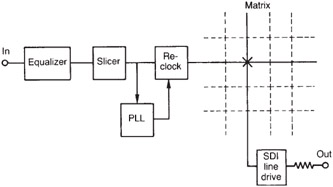Chapter 8: Practical Video Interfacing
| | ||
| | ||
| | ||
Having covered a lot of theoretical ground and described the detail of a number of standards earlier in this book, the purpose of this chapter is to give practical advice in configuring, timing, testing and maintaining digital video interface systems. The techniques and tools needed to test digital interfaces are quite different to the traditional analog approach and will be described here. The great similarity between HD-SDI and SD-SDI means that the same installation and test principles apply. In practice the higher frequency of the HD signal means that the effect of a shortcoming will be more serious in HD.
8.1 Digital Video Routing
Digital routers have the advantage that they need cause no loss of signal quality as they simply pass on a series of numbers . Analog routers inevitably suffer from crosstalk and noise, however well made, and this reduces signal quality on every pass.
The parallel router is complex because of the large number of conductors to be switched and is obsolete. A serial router is potentially very inexpensive as it is a single-pole device. It can be easier to build than an analog router because the digital signal is more resistant to crosstalk. Large routers can easily be implemented with SDI and the long cable drive capability means that large broadcast installations can be tackled.
A serial router can be made using wideband analog switches, so that the input waveform is passed from input to output. This is an inferior approach, as the total length of cable that can be used is restricted; the input cable is effectively in series with the output cable and the analog losses in both will add.
The correct approach is for each router input to reclock and slice the waveform back to binary. Figure 8.1 shows a typical reclocking SDI router. Following the input reclocking stage the actual routing takes place on logic level signals prior to a line driver that relaunches a clean signal. The cables to and from the router can be maximum length as the router is effectively a repeater.

Figure 8.1: A router for SDI signals should be constructed as shown here with a reclocker/slicer at each input to restore the received waveform to clean binary logic levels. The routing matrix proper is then a logic element which is followed by SDI line drivers. If this is not done the output cable is electrically in series with the input cable and the performance margin will be impaired. There is no need to descramble or decode the signal as the router is not interested in its meaning.
It is not necessary to unscramble the serial signal at the router. A phase-locked loop is used to regenerate the bit clock. This rejects jitter on the incoming waveform. The waveform is sliced, and the slicer output is sampled by locally regenerated clock. The result is a clean binary waveform, identical to the original driver waveform. The Gennum GS9005 is an equalizer/reclocker suitable for such an application because it does not descramble the data stream.
The router is simply a binary bitstream switch, and is not unduly concerned with the meaning or content of the bitstream. It does not matter whether the bitstream is HD, PAL, NTSC or 4:2:2 or whether or not ancillary data are carried the information just passes through.
The only parameter of any consequence is the bit rate. HD runs at 1.485 Gbits/s, SD component runs at 270 or 360 Mbits/s, PAL runs at 177 Mbits/s and NTSC runs at 143 Mbits/s. Whilst it is possible to make a router that will handle HD or SD, this would currently be an expensive option. Many multi-standard routers require a link or DIP switch to be set in each input in order to select the appropriate VCO centre frequency. A separate VCO adjustment may be present for each standard. Otherwise units can be standards independent, which allows more flexibility and economy. With a mixed standard router, it is only necessary to constrain the control software so that inputs of a given standard can only be routed to outputs connected to devices of the same standard and one router can then handle component and composite signals simultaneously .
| | ||
| | ||
| | ||
EAN: 2147483647
Pages: 120